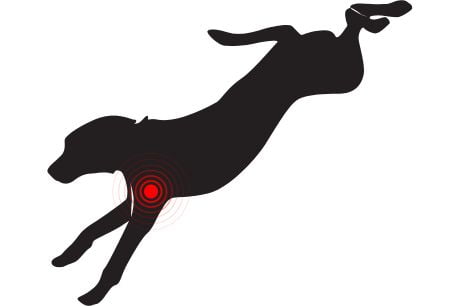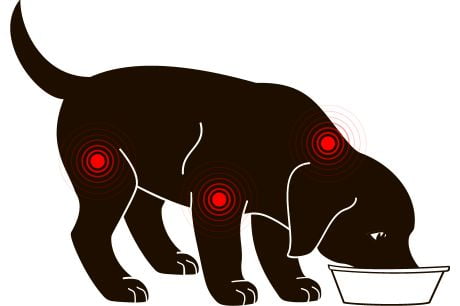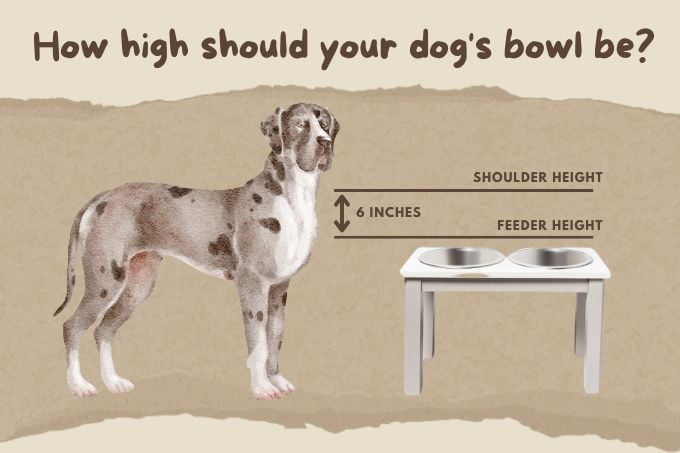This post may contain affiliate links, which means we may receive a commission from purchases made through these links. See our affiliate disclaimer.
If you’ve been wondering whether switching to an elevated bowl for your aging dog is the right choice, you’ve come to the right place. We’ve done all the research on this matter, gathered opinions from credible resources, and we present them to you in simplified form below.
The spoiler version — are elevated dog bowls better for older dogs? The short answer: yes, with some buts. The long answer: it depends, as it often does. Read on below to learn more about the long answer.

Dogs that will benefit from elevated dog bowls
Most dogs while derive some benefit from eating from raised bowls — it is after all a more comfortable position for their necks. Whatever their age, not having to lower their heads too far over for the 2-5 minutes it takes them to finish their food, on a daily basis at that, will make a big difference in their level of comfort.
Dogs with arthritis
Older dogs, however, are more likely to have a joint condition like arthritis, which makes lowering their heads more difficult, and often even painful. One leading resource on the matter claims 4 out 5 older dogs are afflicted with this disease.
Osteoarthritis is the most common type of arthritis in dogs, commonly caused by repeated, low-grade trauma to a joint. While it can affect any joint in a dog’s body, it usually affects the larger joints (hips, shoulders) first. Dogs with arthritis of the larger joints will have a difficult time bending their head over and keeping it in a bent position for the few minutes it takes to eat their food.

To picture “repeated, low-grade trauma,” imagine your dog jumping off the couch and landing on the floor on his front legs. The brunt of that contact, absorbed by his shoulder joints, is considered low-grade trauma. Now think about the hundreds or thousands of times your dog has done this over the years. It’s part of the normal wear & tear of your dog’s joints over the course of his life, resulting in arthritis in his older years.
Dogs with neck arthritis
Osteoarthritis is a progressive disease, which means it will get worse over time. Other large joints will get affected, and eventually joints in the neck (cervical spine) will too.

While there is nothing we can do to reverse the disease, i.e. there is no cure for osteoarthritis, there are measures to be taken to slow its progression. Using an elevated dog bowl for feeding is one of those measures — it can relieve pressure on the neck while your dog is eating. This can be a huge boost in comfort for dogs with advanced arthritis.
Dogs that may NOT benefit from elevated dog bowls
A study done in the 1990s by Purdue University identified risk factors that can cause bloat in large-breed dogs already known to be at high risk for this disease. Bloat is a life-threatening condition, where dogs’ stomachs fill up with gas & blood circulation is cut off.
This was a statistical study whose results have not been reproduced since (i.e., confirmed by other studies), but still warrants consideration. We summarize the risk factors identified below, which includes the use of elevated dog bowls.
The Purdue Bloat Study
Again, only certain large-breed dogs already known to be at high risk for bloat were included in this study. The breeds identified were Great Danes (highest risk), Irish Setters, Irish Wolfhounds, Weimaraners, Bloodhounds, Akitas, Poodles, German Shepherds & Boxers.
Other risk factors identified in the study were: older age, dogs with deep & narrow chests, eating too quickly, eating a single, large daily meal (as opposed to multiple, smaller meals), eating dry dog food, eating from elevated dog bowls, and dogs with anxious temperament.
We want to reiterate here that this study has not been substantiated by any further studies. In the world of medical research, a single assertion would ideally be corroborated by multiple studies before being validated as confirmed. Therefore, we must caution that the conclusions presented in the Purdue study not be taken as incontrovertible facts.
Our recommendations
If your dog is one of the breeds mentioned above as being high risk for bloat, you should definitely have a conversation with your vet about it. Educate yourself on the signs & symptoms of bloat, and what to do if you notice any of these signs & symptoms. We advise not using elevated dog bowls for these dog breeds, at least until there is more conclusive evidence of the risks involved.
No small-breed or medium-breed dogs were included in this study; therefore, no conclusions could be made about them. We advise weighing the benefits vs potential risks of using an elevated dog bowl for your small- or medium-breed dogs. Consulting with your vet about it is always a good idea.
When are dogs considered “old”?
Small-breed dogs have a longer lifespan of around 12-15 years, and accordingly they can be considered “old” or a “senior dog” at around 7-10 years old.
Large-breed dogs have a shorter lifespan, around 10-12 years for Labradors, so they’re considered senior at an earlier age, about 6-7 years old.
The above is just a general guide, the average age at which dogs start showing signs of aging. Some common signs of aging to watch out for in dogs: becoming less active or slowing down, hair graying around the muzzle & eyes, arthritis, failing sight and/or hearing, age spots on his skin.
How high should your dog’s bowl be?

The appropriate height for an elevated dog bowl is when your dog won’t have to bend too far over to reach his food, causing joint & neck strain.
The bowl will ideally be a few inches below a dog’s shoulders (while he’s standing on all fours), such that he must lower his head that those few inches to reach his food. This is the basis for our rough guide above.

